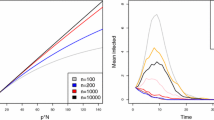Summary
The continually rising trend in the incidence of venereal diseases, especially gonorrhoea, in a large number of countries, both developed and developing is causing considerable public health concern. There is a disquieting volume of human suffering involved, as well as large economic losses in treatment and hospitalization. The present paper reviews the existing state of development in the mathematical modelling of the relevant disease dynamics. The ‘criss-cross’ nature of the infections, which in heterosexual contacts switch between the male and female populations, together with the nonlinear form of the rate of spread normally occurring in infectious diseases, leads to special types of simultaneous nonlinear differential equations.
The simplest deterministic models available entail threshold phenomena connecting the maintenance of endemic states to the contact-rates, the personto-person infection-rates, and the removal-rates. A few stochastic results are also available.
Special attention is given to the aspects of nonhomogeneous mixing, analysis of contact-rates, infection without immunity, allowance for asymptomatic infection, the recognition of many different classes of infected individuals, and the problems of public health forecasting and control. In some cases transient solutions of the equations can be used to forecast future trends in disease incidence, depending on appropriate assumptions about alternative public health interventions.
It is concluded that further mathematical work should be concentrated on relatively simple models comprising no more than three or four district epidemiological groups for each sex. There should be both (i) more intense mathematical investigations, and (ii) new attempts to assimilate the models directly to public health venereal disease control.
Similar content being viewed by others
References
Bailey, N. T. J.: The Mathematical Theory of Infectious Diseases. London: Griffin 1975
Bartlett, M. S.: The relevance of stochastic models for large-scale epidemiological phenomena. Appl. Statis., 13, 2–8 (1964)
Bartlett, M. S.: Some notes on epidemiological theory. In: Research Paper in Statistics: Festschrift for J. Neyman (F. N. David, ed.), pp. 25–36. New York: Wiley 1966
Brauer, F., Nohel, J. A.: Qualitative Theory of Ordinary Differential Equations. New York: Benjamin 1969
Constable, G. M.: The problem of V.D. modelling. Proc. 40th Session ISI, 2, 256–263 (1975)
Cooke, K. L., Yorke, J. A.: Some equations modelling growth processes and gonorrhea epidemics. Math. Biosci., 16, 75–101 (1973)
Dietz, K.: Malaria models. Adv. Appl. Prob., 3, 208–210 (1971)
Dietz, K., Molineaux, L., Thomas, A.: A malaria model tested in the African Savannah. Bull. Wld Hlth Org., 50, 347–357 (1974)
Fanshel, S.: A meaningful measure of health for epidemiology. Int. J. Epid., 1, 319–337 (1972)
Griffiths, D. A.: A bivariate birth-death process which approximates to the spread of disease involving a vector. J. Appl. Prob., 9, 65–75 (1972)
Griffiths, D. A.: Multivariate birth-and-death processes as approximations to epidemic processes. J. Appl. Prob., 10, 15–26 (1973)
Henderson, R. H.: The control of syphilis and gonorrhea: an opportunity for a contribution by more conscious use of mathematics. Proc. SIMS Conf. Epidemiol., pp. 1–5, Philadelphia: SIAM 1975
Hethcote, H. W.: Asymptotic behaviour and stability in epidemic models. In: Lecture Notes in Biomathematics, Vol. 2, 83–92. New York: Springer 1974
Hethcote, H. W.: Mathematical models for the spread of infectious diseases, In: Proc. SIMS Conf. Epidemiol., pp. 122–131, Philadelphia: SIAM 1975
Hethcote, H. W.: Qualitative analysis of communicable disease models. Math. Biosci., 28, 335–356 (1976)
Kermack, W. O., McKendrick, A. G.: Contributions to the mathematical theory of epidemics. Proc. Roy. Soc., A, 115, 700–721 (1927)
Lajmanovich, A., Yorke, J. A.: A deterministic model for gonorrhea in a nonhomogeneous population. Math. Biosci., 28, 221–236 (1976)
Nold, A.: The infectee number at equilibrium for a communicable disease. Math. Biosci. (in press) (1979)
Rao, M. S.: Estimation of the Incidence of Syphilis and some Considerations on its Epidemiology in Allegheny County, Pennsylvania. Ann Arbor, Michigan: Univ. Microfilms. (Sc.D. Thesis: University of Pittsburgh.) 1970
Reynolds, G. H.: A Control Model for Gonorrhea. Ann Arbor, Michigan: Univ. Microfilms. (Ph.D. Dissertation: Emory Univ.) 1973
Reynolds, G. H., Chan, Y.-K.: A control model for gonorrhea. Proc. 40th Session ISI, 2, 264–279 (1975)
Weiss, G. H.: Asymptotic correction terms for the theory of the simple epidemic. Proc. SIMS Conf. Epidemiol. pp. 144–150. Philadelphia: SIAM 1975
Weiss, G. H., Dishon, M.: Asymptotic behaviour of a generalization of Bailey's simple epidemic Adv. Appl. Prob., 3, 220–221 (1971)
World Health: Sexually Transmitted Diseases, Geneva: WHO 1975
Yorke, J. A., Hethcote, H. W., Nold, A.: Dynamics and control of the transmission of gonorrhea. Sex. Trans. Dis., 5, 51–56 (1978)
Yorke, J. A., Nold, A.: The gonorrhea epidemic near equilibrium. (Inst. of Physical Sciences and Technology, University of Maryland: unpublished report.) 1976
Author information
Authors and Affiliations
Rights and permissions
About this article
Cite this article
Bailey, N.T.J. Introduction to the modelling of venereal disease. J. Math. Biology 8, 301–322 (1979). https://doi.org/10.1007/BF00276315
Received:
Issue Date:
DOI: https://doi.org/10.1007/BF00276315




